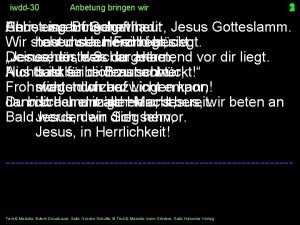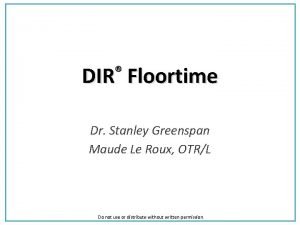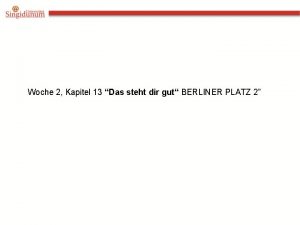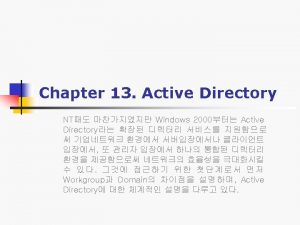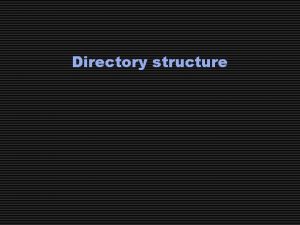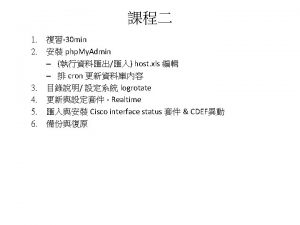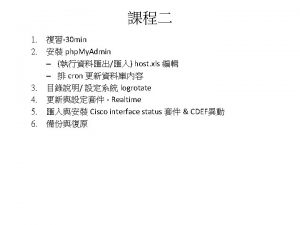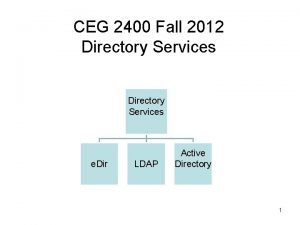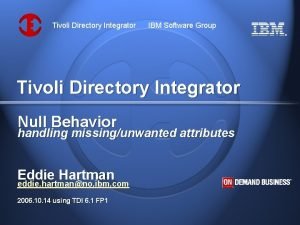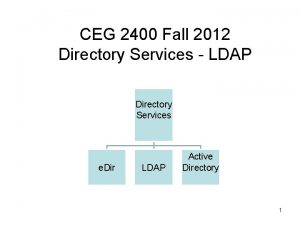Sec Dir A Secure Directory to Defeat Directory





![Directories in Non-inclusive Cache Hierarchies [Yan et al, S&P’ 19] • Trend to have Directories in Non-inclusive Cache Hierarchies [Yan et al, S&P’ 19] • Trend to have](https://slidetodoc.com/presentation_image_h2/5abdac0f1b5e7128ec0459a8ef0e50e1/image-6.jpg)
![Directories are Vulnerable to Side-Channel Attacks [Yan et al, S&P’ 19] • Every single Directories are Vulnerable to Side-Channel Attacks [Yan et al, S&P’ 19] • Every single](https://slidetodoc.com/presentation_image_h2/5abdac0f1b5e7128ec0459a8ef0e50e1/image-7.jpg)















![Conclusion • Directories are vulnerable to side-channel attacks [Yan et al, S&P’ 19] • Conclusion • Directories are vulnerable to side-channel attacks [Yan et al, S&P’ 19] •](https://slidetodoc.com/presentation_image_h2/5abdac0f1b5e7128ec0459a8ef0e50e1/image-23.jpg)




![Directories in Non-inclusive Cache Hierarchies [Yan et al, S&P’ 19] • Trend to have Directories in Non-inclusive Cache Hierarchies [Yan et al, S&P’ 19] • Trend to have](https://slidetodoc.com/presentation_image_h2/5abdac0f1b5e7128ec0459a8ef0e50e1/image-28.jpg)


![Directories are Vulnerable to Attacks [Yan et al, S&P’ 19] • Every single line Directories are Vulnerable to Attacks [Yan et al, S&P’ 19] • Every single line](https://slidetodoc.com/presentation_image_h2/5abdac0f1b5e7128ec0459a8ef0e50e1/image-31.jpg)






![Directories are Vulnerable to Attacks [Yan S&P’ 19] • As the victim re-accesses the Directories are Vulnerable to Attacks [Yan S&P’ 19] • As the victim re-accesses the](https://slidetodoc.com/presentation_image_h2/5abdac0f1b5e7128ec0459a8ef0e50e1/image-38.jpg)











- Slides: 49

Sec. Dir: A Secure Directory to Defeat Directory Side-Channel Attacks Mengjia Yan*, Jen-Yang Wen, Christopher W. Fletcher, Josep Torrellas University of Illinois at Urbana-Champaign *University of Illinois at Urbana-Champaign/MIT ISCA, June 2019

Motivation • Cache-based side-channel attacks are serious security threats • Directories are also vulnerable to side-channel attacks [Yan et al, S&P’ 19] • It is challenging to design secure directories inexpensively and scalably Core L 1 L 2 L 2 directory Shared LLC Sec. Dir – ISCA’ 19 2

Contribution: A Secure Directory (Sec. Dir) • Key: Block directory interference between processes • Main idea: Take a portion of the storage used by conventional directory and re-assign it to per-core private directory (Victim Directory) Core L 1 Core L 1 L 2 L 2 directory VD Shared LLC Sec. Dir – ISCA’ 19 3

Outline • Background • The Problem • Threat Model • Sec. Dir Design • Evaluation Sec. Dir – ISCA’ 19 4

Directory Basics • Directory is used to keep presence information for cache lines • A directory entry contains “sharer information”, address tag, coherence state – Sharer information: N presence bits, where N is # of cores in machine • Directory is partitioned into slices like LLC using a hash function Sec. Dir – ISCA’ 19 5
![Directories in Noninclusive Cache Hierarchies Yan et al SP 19 Trend to have Directories in Non-inclusive Cache Hierarchies [Yan et al, S&P’ 19] • Trend to have](https://slidetodoc.com/presentation_image_h2/5abdac0f1b5e7128ec0459a8ef0e50e1/image-6.jpg)
Directories in Non-inclusive Cache Hierarchies [Yan et al, S&P’ 19] • Trend to have non-inclusive cache hierarchies • Added Extended Directory to hold state for lines that are in private caches (L 2) Slice of Intel Skylake-X/SP LLC and directory Sec. Dir – ISCA’ 19 6
![Directories are Vulnerable to SideChannel Attacks Yan et al SP 19 Every single Directories are Vulnerable to Side-Channel Attacks [Yan et al, S&P’ 19] • Every single](https://slidetodoc.com/presentation_image_h2/5abdac0f1b5e7128ec0459a8ef0e50e1/image-7.jpg)
Directories are Vulnerable to Side-Channel Attacks [Yan et al, S&P’ 19] • Every single line in the cache hierarchy has a directory entry • Directory conflict Evicts victim’s directory entry Evicts victim’s cache line • Root cause: Limited per-slice directory associativity attacker victim Private cache LLC slice core 1 core 0 core 2 …… … …… …… …… …… extended directory (ED) attacker traditional directory (TD) cache lines Sec. Dir – ISCA’ 19 7

Defense Goal & Threat Model Goal: A secure directory to block directory interference between processes Co-location Same-core Attack Strategy Active Cross-core X Passive * Victim self-conflicts (e. g. in victim’s private structures) are not considered leakage Sec. Dir – ISCA’ 19 8

Naïve Secure Directory Designs Are Not Scalable • Strategy I: Substantially increase associativity of each directory slice – Unrealistic: Need too high associativity (e. g. > 300 for a 22 -core machine) … Sec. Dir – ISCA’ 19 9

Naïve Secure Directory Designs Are Not Scalable • Strategy I: Substantially increase associativity of each directory slice – Unrealistic: Need too high associativity (e. g. > 300 for a 22 -core machine) • Strategy II: Way-partition the directory slice (at least 1 way per security domain) – Unacceptable: Inflexible, low performance and limiting Sec. Dir – ISCA’ 19 10

Our proposal: Sec. Dir Slice of Intel Skylake-X directory. Main idea: Take part of the storage used by conventional directory and re-assign it to percore private directories: Victim Directories (VD) VD bank Slice of Sec. Dir. Provide per-core isolation Sec. Dir – ISCA’ 19 11

Our proposal: Sec. Dir • Provides inexpensive and scalable isolation • Uses modest storage N: number of cores S: number of slices VD size for a core is constant irrespective to N Sec. Dir – ISCA’ 19 12

Sec. Dir Blocks Directory Interference • Consider each directory transition and its security implications Sec. Dir – ISCA’ 19 13

Sec. Dir Blocks Directory Interference • Consider each directory transition and its security implications – ED TD: Line location does not change; no leakage Sec. Dir – ISCA’ 19 14

Sec. Dir Blocks Directory Interference • Consider each directory transition and its security implications – ED TD: Line location does not change; no leakage – ② TD Memory: Line is in LLC but in no L 2; It is because of L 2 self-conflicts, not due to attacker Sec. Dir – ISCA’ 19 15

Sec. Dir Blocks Directory Interference • Consider each directory transition and its security implications – ED TD: Line location does not change; no leakage – ② TD Memory: Line is in LLC but in no L 2; It is because of L 2 self-conflicts, not due to attacker – ③ TD VD: Line location does not change. VD of every sharer receives a copy. no leakage Sec. Dir – ISCA’ 19 16

Sec. Dir Blocks Directory Interference • Consider each directory transition and its security implications – – ED TD: Line location does not change; no leakage ② TD Memory: Line is in LLC but in no L 2; It is because of L 2 self-conflicts, not due to attacker ③ TD VD: Line location does not change. VD of every sharer receives a copy. no leakage ⑤ VD Memory: L 2 line is evicted; VD self-conflict, not due to attacker Sec. Dir prevents cache line evictions due to attacker induced directory interference Sec. Dir – ISCA’ 19 17

Sec. Dir Optimizations • Provides high associativity in VD – VD supports Cuckoo hashing to increase effective VD associativity • Delivers efficient directory lookup – Uses a “Early-Miss” (EM) bit skips many VD lookups Sec. Dir – ISCA’ 19 18

Experimental Setup and Benchmarks • Configurations: two 8 -core designs – Baseline: Use Skylake-X directory (ED associativity=12) – Sec. Dir: Take 4 ways from the ED to create the VD • Remaining ED is as big as L 2 • Augment VD in each slice with 28. 5 KB per-core VD is as big as L 2 • Benchmarks: – SPEC Mixes: Groups of programs running 8 threads, with different characteristics – PARSEC: Individual parallel programs running with 8 threads Sec. Dir – ISCA’ 19 19

Evaluation Results – PARSEC • ED/TD conflicts migrate entries to VD without evicting L 2 lines fewer L 2 misses B: baseline S: Sec. Dir – ISCA’ 19 20

Evaluation Results – PARSEC • Under benign conditions, the performance overhead is negligible + Fewer L 2 misses - VD accesses add 5 -10 cycles Summary: Secure and little performance impact Sec. Dir – ISCA’ 19 21

More in the paper & Discussion • More performance results for SPECMIX • Security discussion – VD timing issues • Performance evaluation – Effects of the two optimizations: cuckoo hashing and Early-Miss bits – Storage and area overhead Sec. Dir – ISCA’ 19 22
![Conclusion Directories are vulnerable to sidechannel attacks Yan et al SP 19 Conclusion • Directories are vulnerable to side-channel attacks [Yan et al, S&P’ 19] •](https://slidetodoc.com/presentation_image_h2/5abdac0f1b5e7128ec0459a8ef0e50e1/image-23.jpg)
Conclusion • Directories are vulnerable to side-channel attacks [Yan et al, S&P’ 19] • Naïve solutions are not effective • Contribution: Sec. Dir – Main idea: Take a portion of the storage used by conventional directory and re-assign it to per-core private directory (Victim Directory) – Provides isolation inexpensively and scalably – Uses moderate storage Sec. Dir – ISCA’ 19 23

Q&A

Sec. Dir Blocks Directory Interference • Consider each directory transition and its security implications – – ED TD: Line location does not change; no leakage ② TD Memory: Line is in LLC but in no L 2; L 2 self-conflicts ③ TD VD: Line location does not change. VD of every sharer receives a copy. no leakage ④ VD TD: L 2 wants to write back the cache line to LLC; L 2 self-conflict Sec. Dir – ISCA’ 19 25

Evaluation of SPECMIX • Under benign conditions, the performance overhead is negligible + ED/TD conflicts migrate entries to VD: do not evict L 2 lines fewer L 2 misses - VD accesses add 5 -10 cycles Summary: Secure and little performance impact Sec. Dir – ISCA’ 19 26

Evaluation of SPECMIX • Sec. Dir has fewer L 2 misses because fewer directory conflicts • No VD hits (since no shared data) VD accesses add to a DRAM latency Sec. Dir – ISCA’ 19 27
![Directories in Noninclusive Cache Hierarchies Yan et al SP 19 Trend to have Directories in Non-inclusive Cache Hierarchies [Yan et al, S&P’ 19] • Trend to have](https://slidetodoc.com/presentation_image_h2/5abdac0f1b5e7128ec0459a8ef0e50e1/image-28.jpg)
Directories in Non-inclusive Cache Hierarchies [Yan et al, S&P’ 19] • Trend to have non-inclusive cache hierarchies – #cores ↑, LLC size ↑, latency ↑; – Thus, we want LLC access ↓, L 2 size ↑ – Too much duplication if inclusive • Added Extended Directory to hold state for lines in private caches (L 2) Slice of Intel Skylake-X/SP LLC and directory. Sec. Dir – ISCA’ 19 28

Naïve Secure Directory Designs • Strategy I: Substantially increase associativity of each directory slice – Unrealistic: Need too high associativity … To hide one cache block from the victim, it requires WED + WTD > WL 2 x (N-1) + WL 3 where W is associativity. Sec. Dir – ISCA’ 19 29

Evaluation Results – PARSEC Similar results except that VD sometime hits: - P 1 brings data and its dir is evicted into VD - P 2 accesses the data Still: Few VD hits: - Speed of VD does not matter much Sec. Dir – ISCA’ 19 30
![Directories are Vulnerable to Attacks Yan et al SP 19 Every single line Directories are Vulnerable to Attacks [Yan et al, S&P’ 19] • Every single line](https://slidetodoc.com/presentation_image_h2/5abdac0f1b5e7128ec0459a8ef0e50e1/image-31.jpg)
Directories are Vulnerable to Attacks [Yan et al, S&P’ 19] • Every single line in the cache hierarchy has a directory entry • Attacker can cause conflicts in the directory evicting a victim directory entry – This, in turn, evicts a victim cache line Private L 2 victim attacker core 0 core 1 …… … cache lines Shared LLC slice …… …… …… extended directory (ED) traditional directory (TD) Sec. Dir – ISCA’ 19 cache directory entry line Target address Attacker's addresses 31

Victim Directory Lookup • First ED/TD: one associative lookup; returns sharer info • Then VD: lookups at multiple VD banks; returns one bit per core Sec. Dir – ISCA’ 19 32

VD Lookups Are Efficient: Not On Critical Paths Transaction ② TD Memory VD Operation ------ ③ TD VD Insert the address into the VDs of all the sharers. No search, cheap ④ VD TD On L 2 writeback: Search all VD banks to find the address and remove all the matches. Expensive, but no on critical paths ⑤ VD DRAM On VD self-conflict: Remove the conflicting address from the VD bank. No search, cheap Read VD banks in batches. Stop when we hit in one Write Search all banks and invalidate the relevant copies Sec. Dir – ISCA’ 19 33

Minimizing VD Self-Conflicts h VD bank 1 (x ) • Organize VD as Cuckoo Directory • Performance: Longer lookup/insert latency • Security: – Reduce VD self-conflicts – Obscures victim self-conflict patterns x h 2 ( x) 1 a b 2 c d 3 e f 4 g Sec. Dir – ISCA’ 19 34

Example: VD Offers High Associativity 1 a b 2 c d 2 f d 3 e ① f relocation 3 e x 4 g c h 1 (x ) • Example: insert x into an almost full VD x h 2 ( x) not changed entry moved entry ② relocation (a) Before inserting item x Sec. Dir – ISCA’ 19 (b) After item x inserted 35

Early Detection of VD Misses • Under benign conditions: VD will be highly underutilized • Want to quickly detect when a VD access will miss save E – Add an Empty Bit (EB) per set and bank – If all the entries in that set of that bank are Invalid EB is set Sec. Dir – ISCA’ 19 36

Sec. Dir Uses Low Area • VD does not store “sharing information” • More cores More bits of sharing information “saved” Baseline: Skylake-X directory (WED=12). Sec. Dir: Take some ED ways for VD. For example, keep WED=8 (such that ED can hold as many lines as L 2). Summary: by stealing 4 ways of ED, we quickly attain a per-core VD that has as many entries as L 2 lines Comparing the number of per-core VD entries machine-wide to the number of L 2 lines. Values above 1 mean that the per-core VD has more entries than lines in L 2. Sec. Dir – ISCA’ 19 37
![Directories are Vulnerable to Attacks Yan SP 19 As the victim reaccesses the Directories are Vulnerable to Attacks [Yan S&P’ 19] • As the victim re-accesses the](https://slidetodoc.com/presentation_image_h2/5abdac0f1b5e7128ec0459a8ef0e50e1/image-38.jpg)
Directories are Vulnerable to Attacks [Yan S&P’ 19] • As the victim re-accesses the data directory entry reloaded • Attacker can observe the directory changing Private cache LLC slice victim attacker core 0 core 1 …… …… … cache directory entry line …… …… …… extended directory (ED) traditional directory Non-inclusive cache hierarchy target address attacker's addresses cache lines Sec. Dir – ISCA’ 19 38

Other Results in the Paper • In an attack, the VD does prevent victim misses • The Empty bit (EB) saves 60 -80% of the VD accesses • Under worst attack (i. e. , all victim directory entries in the VD), the Cukoo hashing eliminates many of the self-conflicts • Storage and area overhead of Sec. Dir is small for 8 cores (for 44 cores, break even) Sec. Dir – ISCA’ 19 39

Directory Basics (Snoop filter, Core valid bits) • Directory entry contains “sharer information” for a cache line. – E. g. , 1 dirty bit + N presence bits, where N is # of cores in machine • Directory partitioned into slices like LLC using a hash function • As the number of cores increases, tendency toward non-inclusive caches. Added Sec. Dir – ISCA’ 19 #w ay s Data Coherence State #sets Address Tag Sharer Information Extended Directory to hold state for lines in pvt caches (L 2) 40

Ideal Secure Directory • Set aside some dir area to support many isolated partitions inexpensibly and scalably. • Each partition should provide high associativity Victim suffers minimal self-conflicts • Directory needs little area and can provide fast lookups Sec. Dir – ISCA’ 19 41

Current Directory Operation Transaction When ED TD Conflict in ED; Eviction of data from L 2 TD ED Write to a line shared by multiple L 2 Sec. Dir – ISCA’ 19 42

Sec. Dir Operations Provide Isolation Transaction Explanation + Security ② TD Memory Line is in LLC but in no L 2. No leakage ③ TD VD Line location does not change. To be safe, VD of every sharer receives a copy. No leakage ④ VD TD L 2 self-conflict. Requires searching all VDs. Safe leak ⑤ VD -> DRAM VD self-conflict. Cannot move to TD due deadlock. Safe leak Sec. Dir – ISCA’ 19 43

Contribution: A Secure Directory -- Sec. Dir • Take part of the storage used by conventional dir and re-assign it to per-core private dirs: Victim Directory (VD) • Distributed VD for a core holds as many lines as in pvt L 2 • To provide high associativity, VD organized as Cuckoo directory • OK to be slower than main dir because it is a victim dir • Uses modest space because it does not keep sharer info (it is per-core) • Modeled a modified Intel Skylake dir Secure + negligible perf impact Sec. Dir – ISCA’ 19 44

Sec. Dir Properties • Provides inexpensive and scalable isolation • Provides high associativity • Uses low storage • Delivers efficient directory lookup Sec. Dir – ISCA’ 19 45

Benchmarks • SPEC Mixes Profile applications on baseline to classify them into CCF (core cache fit); LLCF (LLC fit); LLCT (LLC thrashing) • PARSEC Sec. Dir – ISCA’ 19 46

Directory Structure • Naïve organization of the “sharer information”: – Each entry has: 1 dirty bit + N presence bits – N: number of cores in the machine • Directory partitioned into slices using hash function • As the number of cores increases, tendency toward non-inclusive caches. Added Extended Directory Sec. Dir – ISCA’ 19 47

Directories for Non-Inclusive Caches Directories are easy targets • To hold a victim line, need a high per-slice associativity: WTD + WED > WL 2 x (N-1) + WL 3 Sec. Dir – ISCA’ 19 48

Directories are Easy Targets • Victim reads line; data goes to L 2 and dir info to ED • Attacker causes ED conflicts: dir info moves from ED to TD • Attacker causes TD conflicts: dir info evicted from TD; data evicted from L 2 Sec. Dir – ISCA’ 19 49
 Les dir oder lies dir
Les dir oder lies dir In dir ist mein leben in dir meine stärke
In dir ist mein leben in dir meine stärke Lies dir das durch
Lies dir das durch Defeat in new york
Defeat in new york Defeat at ai
Defeat at ai Defeat by kahlil gibran
Defeat by kahlil gibran So gold can easily triumph defeat strongest man
So gold can easily triumph defeat strongest man Defeat two factor authentication
Defeat two factor authentication By your spirit i'm alive from the ashes of defeat
By your spirit i'm alive from the ashes of defeat Kneeling in defeat
Kneeling in defeat Golgatha
Golgatha Stelle dir vor
Stelle dir vor Ich gäb dir gerne einen kalender
Ich gäb dir gerne einen kalender Maude le roux
Maude le roux Vertraue gott deine pläne an er wird dir gelingen schenken
Vertraue gott deine pläne an er wird dir gelingen schenken Nimm zeit dir nachzudenken
Nimm zeit dir nachzudenken Greenspan model
Greenspan model Das kleid steht dir gut
Das kleid steht dir gut Die kraft sei mit dir
Die kraft sei mit dir Stelle dir vor
Stelle dir vor Beleidigungen für jeden anlass
Beleidigungen für jeden anlass Was wünschst du dir zu weihnachten
Was wünschst du dir zu weihnachten Ich will dich anbeten
Ich will dich anbeten Feilin məna növləri
Feilin məna növləri Orbene sinonimo
Orbene sinonimo Corrie ten boom wenn du dir die welt anschaust
Corrie ten boom wenn du dir die welt anschaust Sintaxis de dir
Sintaxis de dir Hur vet man om det är ackusativ eller dativ tyska
Hur vet man om det är ackusativ eller dativ tyska Ich gäb dir gerne einen kalender
Ich gäb dir gerne einen kalender Annem ile babamın yaşları toplamı 79 dur
Annem ile babamın yaşları toplamı 79 dur Mein verlangen nach dir
Mein verlangen nach dir Funmail2
Funmail2 Miso
Miso Schwache adjektivdeklination übungen
Schwache adjektivdeklination übungen Ich wünsche dir osteraugen
Ich wünsche dir osteraugen Yarıçapı 10 cm olan çemberin çevresi kaç cm dir
Yarıçapı 10 cm olan çemberin çevresi kaç cm dir Gedicht glück ist gar nicht mal so selten
Gedicht glück ist gar nicht mal so selten Funpot spaß
Funpot spaß Ich danke dir mein himmlischer vater
Ich danke dir mein himmlischer vater Ich schicke dir einen engel-gedicht
Ich schicke dir einen engel-gedicht An dir mag ich besonders
An dir mag ich besonders Denk dir eine zahl
Denk dir eine zahl Alle meine quellen entspringen in dir text
Alle meine quellen entspringen in dir text 20 nin 30 u kaçtır
20 nin 30 u kaçtır Caremark dir fees
Caremark dir fees Hans klenk toilettenpapier
Hans klenk toilettenpapier Frases de dir
Frases de dir Mir dir sich uns euch
Mir dir sich uns euch Hei wie gehts dir
Hei wie gehts dir Ich teile mein bett mit dir
Ich teile mein bett mit dir










